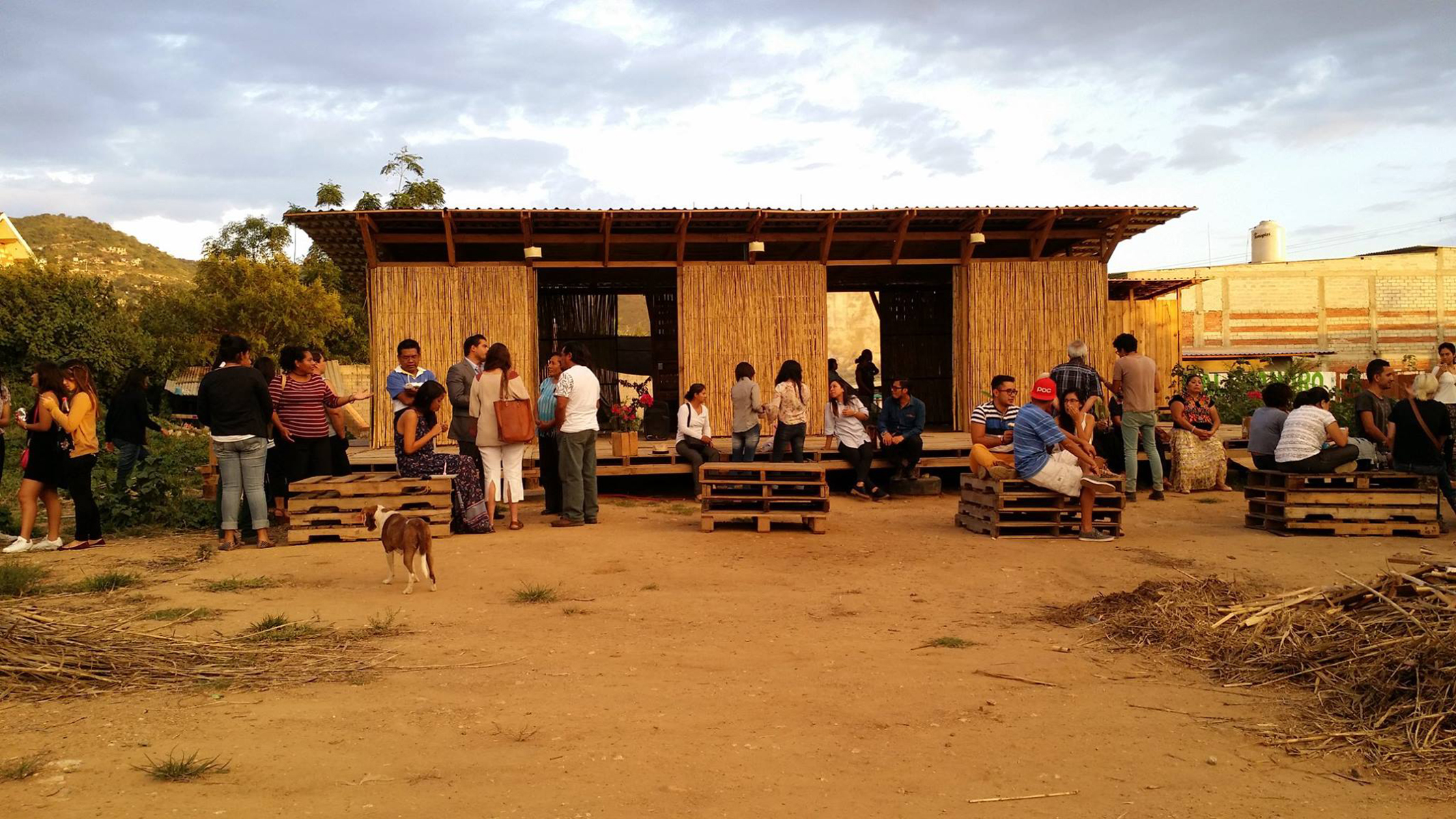Conucos, Shabonos, and WhatsApp: Technologies for Embodied Education and Radical Learning
04/03/2023
How flexible and malleable can curating become in order to provoke a flux of ideas rather than reassert already established concepts? [...] What happens when curating is about being within live processes rather than relating through finished forms?
Waiting for Timber
It was midday. Heat and humidity were starting to kick in. I was in the port of Inírida—the capital city of Guainía, a department of eastern Colombia in the northern Amazonia—where a three-river confluence, known as the Fluvial Star, connects Colombia to Venezuela and Brazil. Small boats kept coming in and out, some filled with tourists, others with local passengers, and others with giant bulks of plantain, yucca, and pineapple, blocking the captain's view, who somehow knew exactly how to maneuver his vessel. Tuk-tuks were picking up people and honking at other drivers. Further down the river basin, the sound roared from the Pajuil market, a local bazaar selling different Amazonian goods such as fresh fish, casabe, fresh chili peppers, and mañoco. I was waiting for Jaime Hernárndez, a man from the Caranocova Yuri resguardo of the Puinave community to arrive.1 Jaime is part of HALAMO, an association created to reforest and mitigate the impact of logging in this area. I was waiting for a shipment of construction materials which included logs, palms and bejucos. I’d never met Jaime in person and hadn't heard from him in days because he was in the Morocoto lagoon with no phone signal. Before losing cell phone reception, he had been specific: we’ll meet in the port at 12:00 noon on May 8th. May 8th arrived, it was noon, and still there were no signs of Jaime. I started to become restless thinking he might not show up. I was accompanied by young men from the Colombian marine who were there to aid in bringing back these materials to the Cuabanare farm, part of the Custodio García Rovira school. They would later on, help in the construction of the project I will shortly go into explaining. The navy men were becoming restless too, as heat and humidity kept rising. I finally saw a man waving at me and knew immediately it was Jaime. I was relieved: the materials for Jardín Maloka, an ethnobotany site for students at the Custodio García Rovira, had arrived.
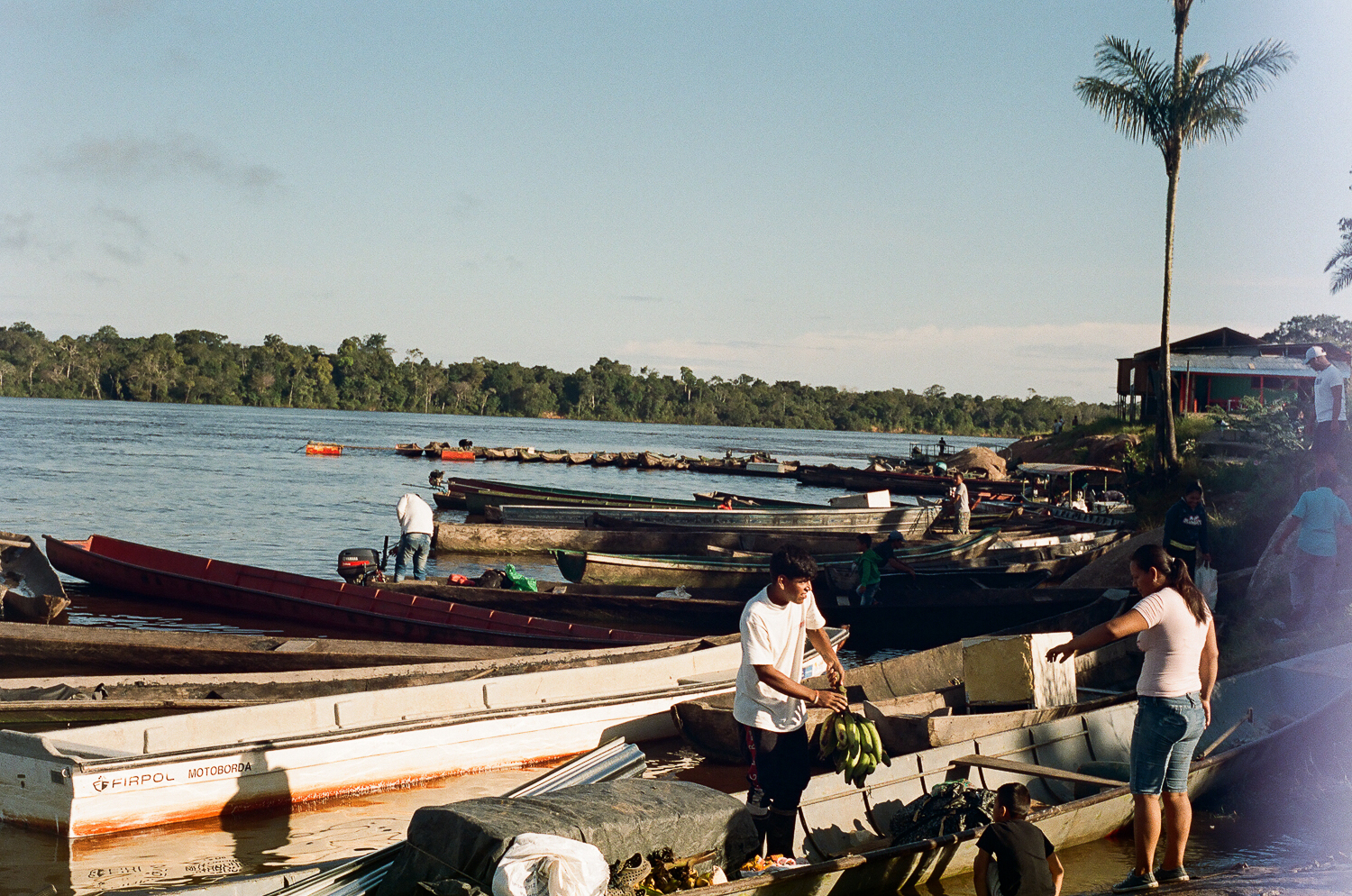
Curating as Process: the Conuco
I am intrigued by the potential available when curating beyond exhibition-making. My interest lies in creating structures that foster collaboration and generate contradictions across multiple voices. How flexible and malleable can curating become in order to provoke a flux of ideas rather than reassert already established concepts? I recently addressed this question when in the Fall of 2021, I was invited to commission a series of projects as curator for Colombia for the Common Ground festival at Bard College.2 I began by creating a web of projects in different territories of Colombia that addressed non-dominant ways of relating to food systems and allowed for other ways of learning.3 What happens when curating is about being within live processes rather than relating through finished forms?
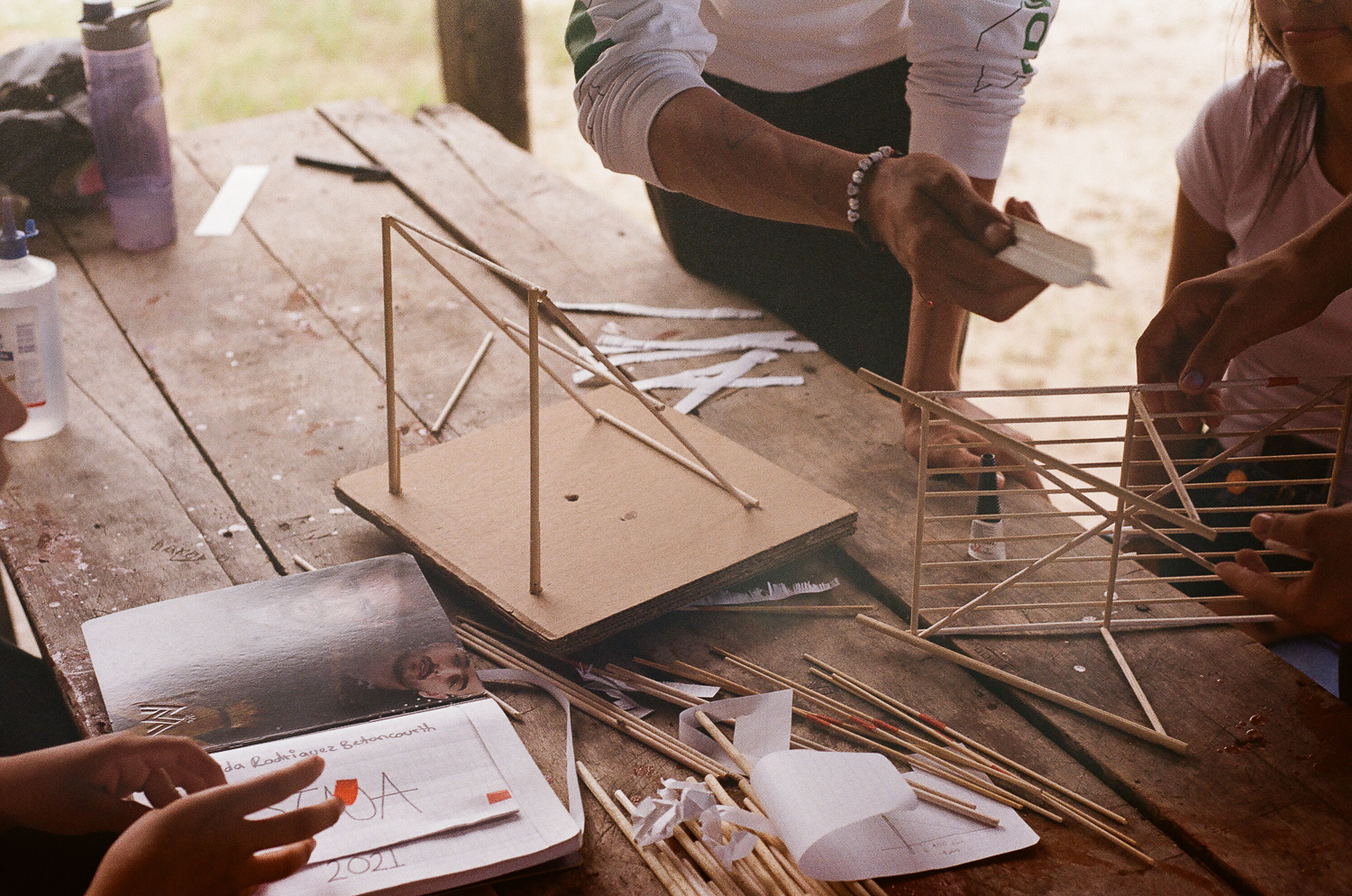


After a trip to La Chorrera in May 2022, I became interested in the chagra or conuco—a physical, educational, and spiritual gathering site where food and medicinal plants are communally grown.4 For different Indigenous communities in the Amazon that use this technology, conucos are places where the elders’ knowledge is transferred to younger generations. The conuco is a learning place where food becomes a vehicle between humans and the environment. It is not only a polyculture site that allows for local foods to be sowed and harvested, it is also a cycle that propels dynamic relationships between biodiversity, culture and people.
Setting the Team and its Collaborators
Just as the conuco is a space for learning, my main goal was to create an ethnobotany site that would allow different practices to weave themselves in order to create other ways of relating to nature and knowledge. The conuco became a metaphor for me and what I wanted to accomplish with Jardín Maloka as a learning site. It was imperative to summon a diverse group of people to join the project. The first call I made was to Nicolás Paris, a multidisciplinary artist with a decidedly pedagogical commitment, who carries out educational projects in different locations such as Timbiquí and Soacha. Paris is constantly finding ways to subvert traditional spaces of learning which he believes revolve around the accumulation of individual knowledge. Second up was Pedro Aparicio, an architect who is convinced that architecture is generally understood in a limited manner and whose work advocates for a multi-species practice where architecture is more about designing in time rather than designing in space.
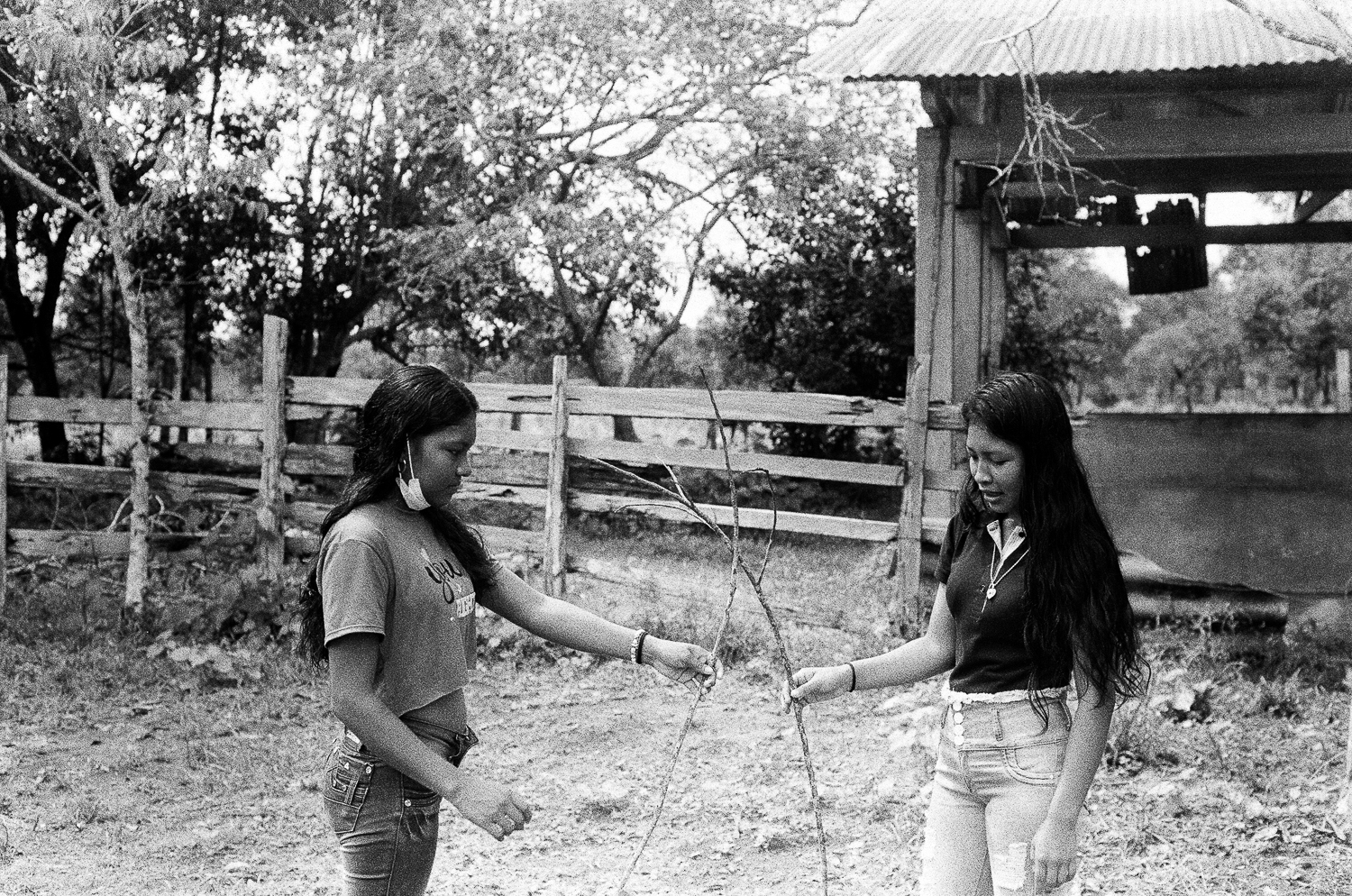



Aparicio introduced me to Francy Méndez, a local Iníridian who works in the government office and has a deep love for her city. She would become the glue to this project, many times knocking on peoples’ doors whenever I would not get a response via phone calls. She put me in touch with Arlex Tovar, headmaster of the Custodio García Rovira school, the first public school in Guainía. He told me he was interested in developing programs around preserving local knowledge and botany. In turn, Tovar introduced me to Rudy Villegas, a teacher at the Custodio García Rovira who teaches agricultural practices and comes from a migrant family from Vaupés. Villegas never learned to speak her parents’ native languages—neither her mom’s Tucano nor her dad’s Guanano—and is convinced that this is a huge loss. He hopes to prevent it in a younger generation. The last one to join was local sabedor Melvino Yavinape from the Coayare resguardo. Melvino teaches subjects as far and wide as weaving, pottery, and ethnobotany—essential knowledge for the Curripaco community to which he belongs—through what he calls escuela ancestral (which in Curripaco is called nacapeetaca, which according to him, roughly translates as ‘transferring experience’).5 These were the people who were brought together to create a site in Inírida where pedagogy, art, and various ways of connecting around food, culture, and the environment fused together. These were the foundations for Jardín Maloka.
Why Inírida, Guainía?
Guainía is a greenway of (bio)diversity, home to 903 plant species, 324 bird species, and over 20 Indigenous communities.6 Throughout history, these communities have been confronted with the violence of colonization and mass evangelization, which have deeply affected them.7 This violence has torn holes in the local fabric, often replacing complex thoughts with flattened and opaque Western alternatives. This has distorted and narrowed the way communities speak about themselves and their practices, and particularly, their profound relationship with the natural world. Much like the flora and fauna in this region, the culture and ancestry of these communities are in rapid decline. It is, of course, unsurprising, given how intimately bonded these communities are to nature and the symbiotic relationship that exists between caring for themselves and their surroundings.
Many of these people are migrating to urban centers, forgetting about their roots and in so doing, jeopardizing the fate of the environment and abandoning sustainable local agricultural practices, such as the conuco. The goal with Jardín Maloka is to encourage children to foster an interest and relationship to these declining practices.
The School
The Custodio García Rovira school has an agricultural program for its students housed in a farm. During calls I had with Arlex (the school director), he showed interest in creating a space to accommodate medicinal plants, as he considers that these have been marginalized by scientists, food producers, and restaurateurs and should play a more prominent role in local food studies. He also mentioned that this space could potentially become part of the network of museos comunitarios, a multi-site museum around Inírida that aims to preserve local culture. The prospect of becoming part of this network of museums was what excited students the most.
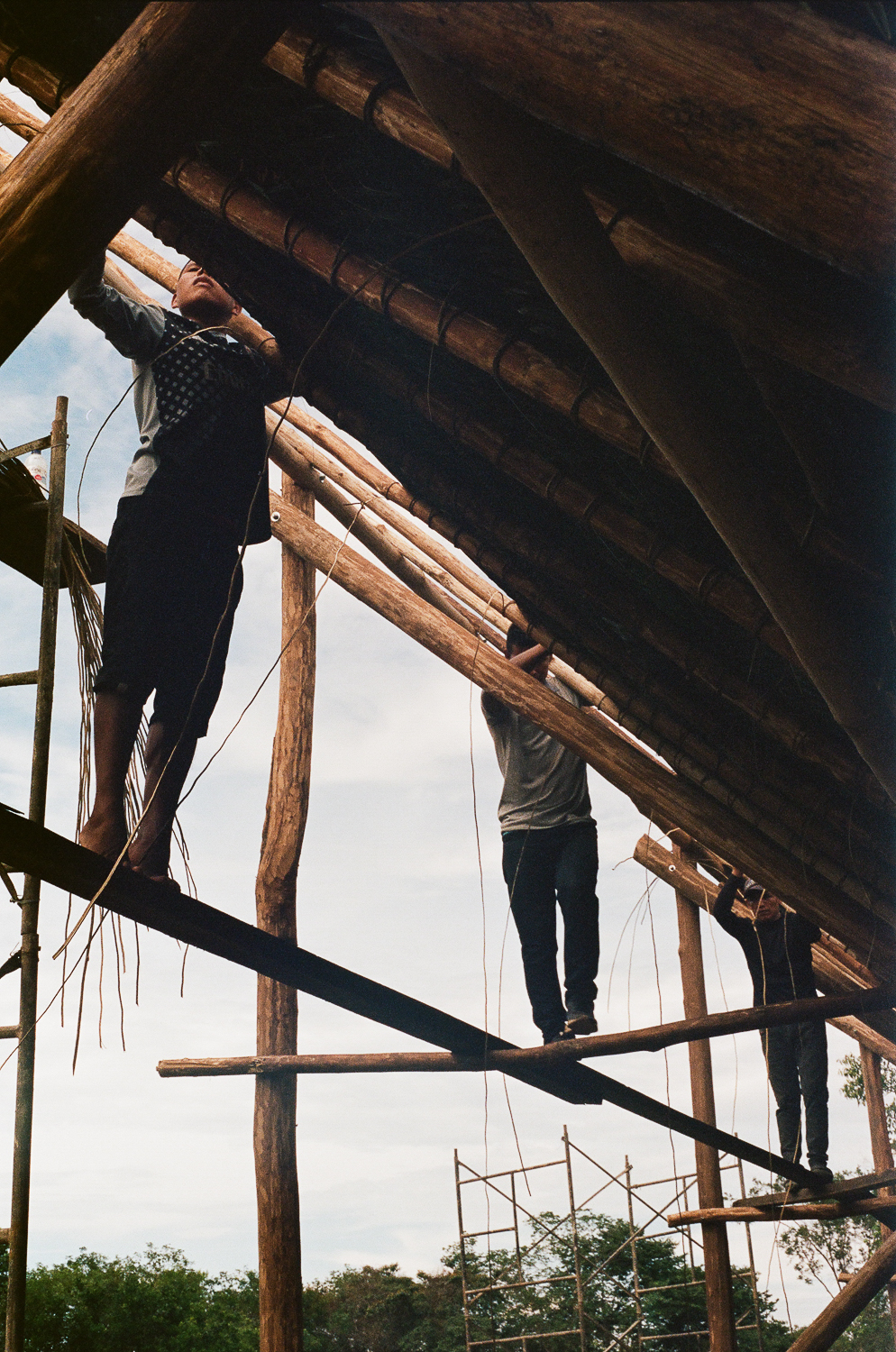
The Custodio García Rovira school had never had enough resources to hire a person like Melvino, whose idiosyncratic mode of teaching did not quite fit into the national curricula and teaching standards. Melvino once told me that through his practice, he merely becomes a channel to teach what is depicted in the petroglyphs found throughout Guainía. Melvino’s aim is to incorporate the educación propia into the national curriculum. I began to think that Jardín Maloka could be the perfect site for encouraging teachings such as Melvino’s; weaving people, teachings and nature together.
Remote Learning (or Remote Sowing)
Between fall 2021 and February 2022, we all worked together–creating connections and trying to understand how to best use the resources from Common Ground and Bard to create a project that would benefit the community and align and contribute with the school’s aim of housing a medicinal orchard in its farm I listened to what the community wanted and needed and how I could become a platform and an avenue for it. On February 28, 2022, I created a WhatsApp group with over 30 students from grade 10, teachers from the Custodio García Rovira school, Melvino, Nicolás Paris, and members from APLO, the architecture office run by Pedro Aparicio.8 We wrote questions in the form of riddles and learned through our exchange about the physical place where this medicinal garden/laboratory was to be housed. The screen became a medium of participatory architecture and pedagogy. We all asked questions and started designing the physical site.
After conversations with the students and teachers from the school, APLO came up with a simple structure inspired by the shabono, a traditional dwelling from the Venezuelan/Brazilian Yanomami community in the Orinoco basin. The shabonos’ unroofed center creates a direct relationship with the immediate environment, acting as a clearing in the forest, and for us, becoming a strategy to demonstrate the potential of architecture when it is not limited by a specific place. The sides of the structure allow for cooking, playing, sleeping, and learning to take place under the same roof. Sailing down the narrow Orinoco River, one can see Colombia on one side and Venezuela on the other. The river connects peoples, cultures, and traditions and we felt it was appropriate to use this dwelling as inspiration for the Amazonian Orinoco communities connected through the river rather than by geographical divisions and frontiers.
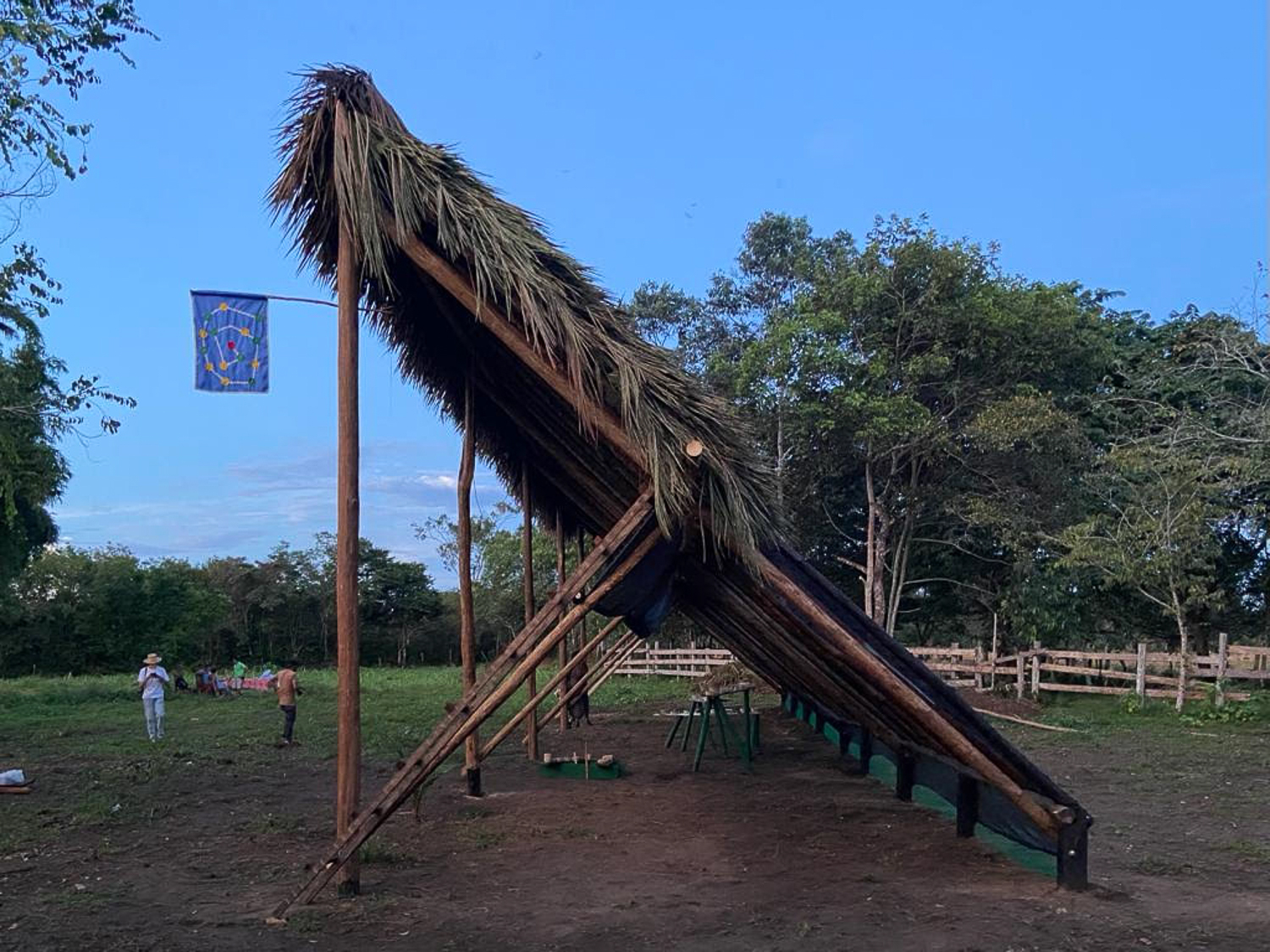

Jaime (the man I had been waiting for at the port) had suggested working with the native almanegra wood (Talauma sp.). He explained how these trunks needed to be carefully cut at specific moments—the full moon, the chirp of birds, and the croak of frogs are clues for knowing when the time is right. And so, with a simple design and locally sourced materials, we arrived in Inírida on May 6th, 2022. We were finally meeting the people and the place we had been seeing through a screen for months.
On-Site: Tracing the Sun with a Hand
The exact location of the dwelling was paramount because even though one of the main objectives of the space was for the structure to be the home to many medicinal plants, it was also meant to invite conversations through them, allowing plants to become a medium or channel for architecture and pedagogy. We prepared workshops led by Paris, where students were asked to think about how plants grow, how they move, and why the sun and the moon are a big part of that conversation. This exercise reflected what Aparicio had once told me about how he understood his practice: “I want to study the abundance of ecosystems—be it rivers, jungles, or oceans—as spaces that are in constant movement. Our prerogative as architects should be to move around and within these systems and not separate from them.”
Responding to the cardinal directions to maximize the sunlight for the plants and also to protect the structure from the strong winter winds of the alluvial valley, we decided the dwelling would be aligned east-west.
Its open space would allow for a more innate conversation with nature in opposition to the Western standard of a learning space which tends to be airtight, hermetically isolating what happens inside the space. Here, we had an opportunity to allow nature to be part of a conversation and of the classroom. Would it work?
We decided to build the roof in chiqui-chiqui palm, woven in a traditional technique from the Puinave and Curripaco communities. Here, Jaime and eight other men from the HALAMO association worked while others, such as Aparicio and his team, learned this local form of embodied knowledge. Seeing these men first open the palm and later weave on a 9-meter structure was like seeing someone dance—every step was a step closer to physically becoming one with the palm.
By prompting students to observe and reflect upon their natural surroundings, Nicolás Paris was determined in creating the right conditions for learning through a series of exercises. For example, by observing the movements of a tree branch at the farm, he had conversations with the students as to how the branch represented the universe, and thus, created an understanding of the ecosystem as a whole, encouraging students to learn from that which is more-than-human, accomplished through radical forms of listening and experiencing nature. These exercises would, later on, become the foundations of the pedagogical multi-disciplinary program for Jardín Maloka and how to relate and use the space.
Melvino organized a few field trips aligned with the escuela ancestral. As part of the project, students had a pottery session with clay from the river at Coco Viejo, a hike into the Ceiba jungle led by a leader of the Tucano community, Delio Jesús Suárez, where students learned about the properties of different medicinal plants and were asked to think of forest and agriculture as one ecological continuum, and a visit to Kenke, a Cultural and Natural Park where different Indigenous technologies from hunting to fishing were explained. These field trips wanted to trigger the interest of the students in their own ecosystems and local foodways.
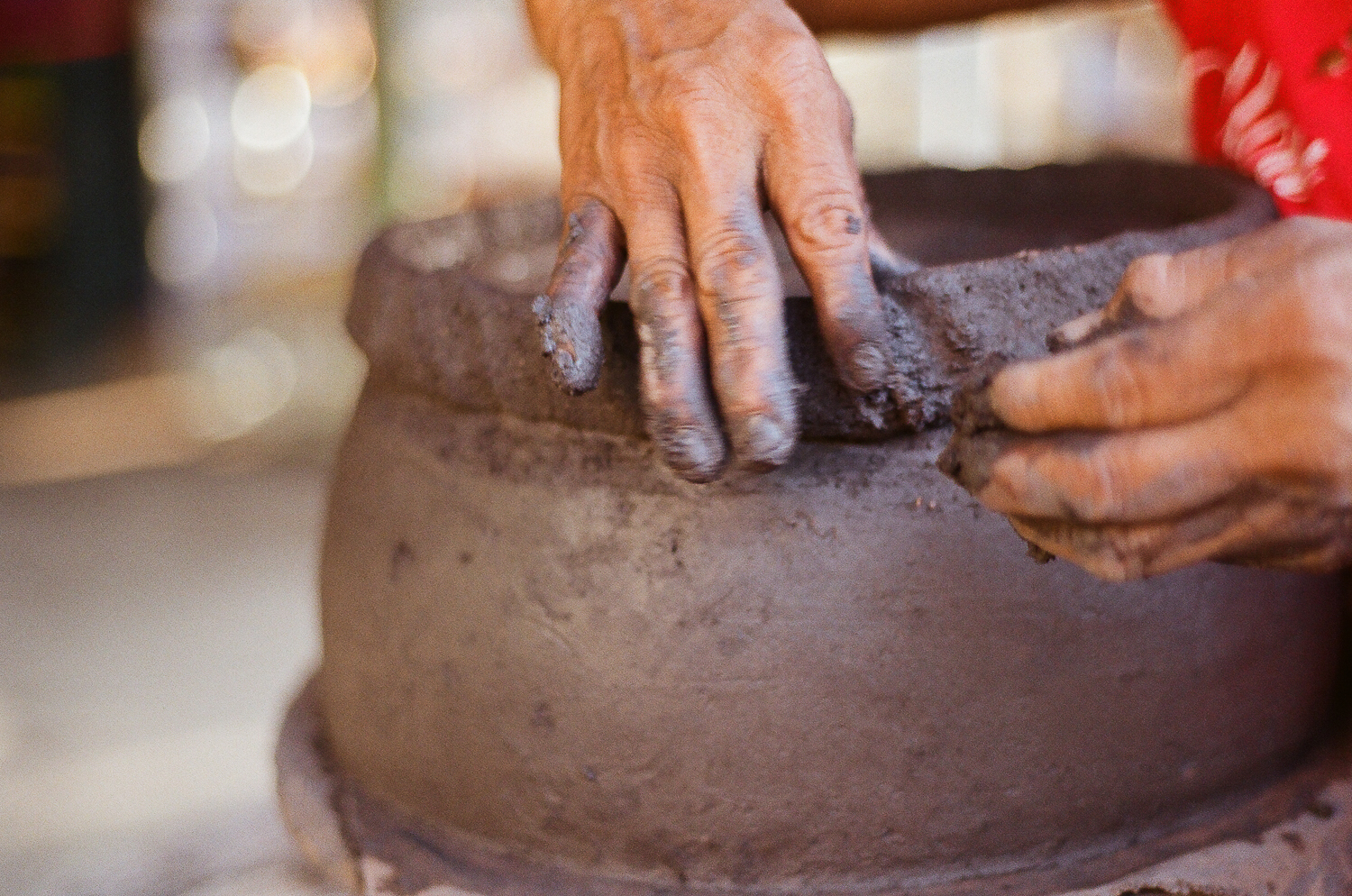
Students were enthralled with the construction, the field trips, and the activities. They would arrive early and leave late, each one of them finding their own interest in specific activities. Some wanted Melvino to tell them more stories about the myths of Mavecure, others would cut and draw images from the natural world next to Paris, while a few jumped on the scaffold to help Aparicio.
Based on one of the activities of Paris’ workshops, a flag became the symbol of the site and was placed on the northern part of the construction. On our last day, 10 days after we had first touched ground in Inírida, we had a communal lunch where Melvino’s wife prepared a feast of local dishes: ajicero, casabe, and yucuta were served. We invited students, teachers, parents, and local sabedores to join us and, together, we discussed ways in which we hoped this newly constructed site space would serve the needs of the community. We wanted to distill all that had happened over our stay at Inírida. On the one hand, together, we had constructed a site: one that would become the home for ethnobotany studies at the school. We talked about the importance of creating a deeper relationship with nature and how medicinal and edible plants were a way to ensure food sovereignty as well as a place for disseminating local knowledge. On the other hand, we wanted to encourage teachers to use it as a classroom that would stimulate other types of learning structures through the pedagogical programs advanced by Paris, with the aim of shifting tired structures of learning.
And finally, but very importantly, the name Jardín Maloka was given to the site. The name was something we had been thinking about with the students since we had first arrived. We all agreed that it should represent the principles of this space: the Maloka as a physical expression of knowledge which allows for a community to live in harmony with nature, and Jardín as a play on words which establishes the great rainforest as a sort of garden.
Back in Bogotá
Four months later, we were back in the city capital, and off-site, understanding from afar how Jardín Maloka is evolving and how it is being lived. We have seen through our screens how the students continue to weave, prepare substrates for the soil, bring medicinal plants from their homes and have become more curious about the natural world. But some have stopped answering our WhatsApp messages, they have maybe lost their internet connection, or, perhaps, interest. Others reply and continue our on-screen dialogue. We have also perceived how tensions have arisen at certain moments: as Arlex pushes for an agenda concerned mostly with the study of medicinal plants, Melvino wishes to continue taking the students to field trips but is constrained by resources, sometimes even sounding defeated over the phone.
After various talks with Melvino, Francy and Rudy, and the inevitable perspective that time brings with it, we believe that future efforts can be allocated into having conversations with the Ministry of Education that could, possibly, become the blueprints of how to incorporate people like Melvino, who teach around educación propia, into the national curriculum or PEI system (Institutional Education Program.) Many people in Colombia are pushing for this agenda, and we believe that the pedagogical program we are developing here can help serve and continue to advance this idea.
The passage of time has also revealed to me the intrinsic differences between a project's planning and conception and its effectual realization. What happens when a project turns out to be something other than the thing it was meant to be? This dissonance between expectation and reality is a reminder that collective and process-based work ebbs and flows over time. It becomes a vehicle that supports both ideas and tensions, rather than having fixed concepts as to how a space should function.
Like a river and its meanders, it is the stream that dictates the current, not the way. Jardín Maloka becomes a place that is transformed through daily life and its daily users. Whoever inhabits this space dictates the use they make of it. And that is my hope for Jardín Maloka (or at least my hope at this present moment).

